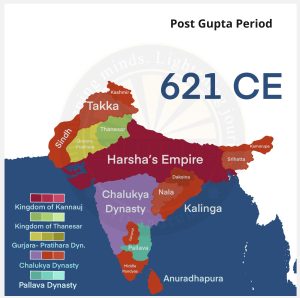Pallava Dynasty
- From 275 CE to 897 CE, the Pallava dynasty ruled much of the Deccan, also known as Tondaimandalam.
Administration
- Pallavas developed agriculture and sea trade, amassing enormous riches, which is reflected in the spectacular temple architecture of the time.
- The Pallava Kingdom was divided into Kottams.
- During the Pallava administration, land concessions were provided to Brahmans (Brahmadeya) and temples Devadhana that were exempt from revenue.
- The group of villages was called ‘Nadu‘.
- The group of Nadus was referred to as ‘Nagaram’ (merchant organization) and the group of Nagarams as ‘Manadalam’.
- Sabhas (assembly) of Brahmin landowners were organized into smaller assemblies/committees that oversaw irrigation, agriculture, roads, and temples.
- Non-Brahmin landowners’ gatherings were known as ‘Ur‘.
- The Pallava inscriptions shed significant insight on village assemblies known as sabhas and associated committees.

Literature
- Kanchi grew into a major center of education, culture, and trade. Kanchi’s Ghatikas (learning centers) were quite popular.
- Pallavas fostered the growth of Tamil language and literature, as well as Sanskrit.
- Patronage for saints resulted in the creation of religious writing.
- Periyapuranam: A collection of Shiva-loving and devotional songs.
- Nalayiram-Divya-Prabandham: A collection of Vishnu-loving and devotional songs.
Architecture and Paintings
- The Pallavas established the Dravidian style of Indian architecture in the South. There was a continuous transition from cave temples to monolithic Rathas, culminating in structure temples.
- Under Pallavas, the main aspects of Dravidian architecture, such as Vimana, Mandapam, and Gopuram, were vividly developed.
- Under Mahendravarman I, miniature rock-cut temples known as Mandapas were built; examples include the Bhairavakona temple and the Anantheshwara temple in Undavalli.
- Narsimhavarman I expanded the mandapas, established Mahabalipuram/Mamallpuram city, and built several monolithic Ratha (Chariot) temples, including the Panchapandavar rathas. Important Mandapams include Varaha, Mahishasuramardhini, and Tirumurthi.
- Narsimhavarman II built Mahabalipuram’s well-known Shore Temple, a UNESCO World Heritage site, and the Kailashnath Temple.
- The Pallavas also contributed to the development of sculpture. Beautiful sculptures cover the Mandapas’ walls.
- The sculpture in Mamallapuram showing the “Descent of Ganges or the Penance of Arjuna” is a work of classical art.
- The paintings in the Sittannavasal caves date back to the Pallava period.
- Mahendravarman I was referred to as Chittirakkarapuli (tiger among painters).
- The Dakshina Chitra (Instruction manual for painters) was compiled during the reign of Mahendravarman I.
Music
- The Kudumianmalai and Thirumayam music inscriptions demonstrate their passion for music.
- Musical instruments included yaazhi, mridangam, and murasu.
- The Mamandur inscription includes information about vocal music notation.
- Both Mahendravarman I and Narasimhavarman I were musical geniuses.
- Dance was popular during the Pallava period, as evidenced by temple sculptures.
Decline of Pallavas
- The Pallava dynasty’s dominance began to diminish in the eighth century when the Cholas and Pandyas seized control of the region.
- Aparajita, the final Pallava ruler, was defeated by Chola king Aditya I, effectively ending the Pallava dynasty’s power.
- Despite their final demise, the Pallavas left a lasting impact on southern India, particularly in the disciplines of art and architecture.
- Today, historians, archaeologists, and art enthusiasts enjoy and study the complex carvings and architectural marvels they constructed.
- The Pallava dynasty’s contributions to Indian culture, as well as its unique architectural style, make it a significant chapter in South Indian history.
- Simhavishnu vanquished Kalabhras and established the rule of imperial Pallavas.
- The Pallavas ascended to power during the reigns of Mahendravarman and Narasimhavarman-I.
- Throughout their rule, they were at odds with the Chalukyas of Vatapi in the north and the Tamil kingdoms of Cholas and Pandyas in the south.
- The Pallavas established their control throughout south Andhra Pradesh and north Tamil Nadu, with Kanchi serving as their capital.
- Kanchi flourished as a temple town and a hub of trade and commerce under their leadership.
- Pallavas are known for their support for the Hindu temple architecture.
- By the time of the Pallavas, the Chalukyas of Badami and the Pandyas of Madurai had started fighting for control of southern India.
